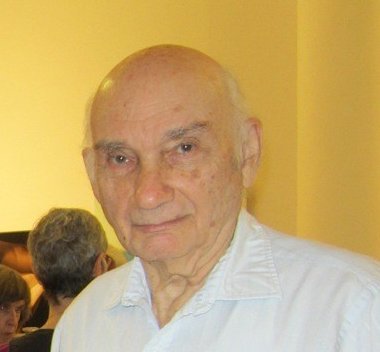Leroy Kanterman
 (1923-2015)
(1923-2015)
Leroy Kanterman, the cofounder and President of the Haiku Society of America, was born on 2 October 1923 and for many years lived in Forest Hills, Queens, N.Y. During the World War II he served in the U.S. Army.
The Haiku Society of America, created in the winter of 1968–69, was the first formally structured organization devoted solely to Western haiku, and it remained the only one for a number of years. On the evening of 23 October 1968, twenty-three men and women met at Asia House in New York City. Harold E. Henderson, with help from Leroy Kanterman and encouragement from the Japan Society of New York, was responsible for the meeting. Kanterman was chosen to head the group that was known at first simply as the Haiku Society. Regular monthly meetings were scheduled, and these were usually held in rooms of the Asia Society or at the offices of the Japan Society. Simple bylaws were drawn up and adopted at the April 1969 meeting and with this the group became the Haiku Society of America. Leroy Kanterman served as its President in 1968–69, and 1972. Over the years the society has grown to embrace over 800 members from all parts of the United States and the world. Meetings, readings, workshops, awards programs, and various publications have provided members with stimulation and opportunities to learn about haiku and related art forms and to share their work with a wide variety of people who have an interest in haiku. The Haiku Society of America has played and continues to play a vital role in the English-language haiku movement.
The Society's journal, Frogpond, has been published since 1978 and appearing three times per year, it contains haiku and related forms of poetry, articles, reviews, contest results, announcements of the Society, and haiku-related news.
Leroy Kanterman was also the Editor of one of the earliest English-language haiku magazines Haiku West. The magazine was edited and published by Leroy Kanterman in New York City, and appeared twice a year from June 1967 until January 1975. More traditionally oriented, the magazine published many quality haiku and senryu. After the formation of the Haiku Society of America in the winter of 1968–69, Haiku West served as its voice.
The establishment of the American Haiku Archive at the California State Library in Sacramento provided for the first time a focal point and central repository for the American haiku movement. The inauguration of the archive was celebrated in ceremonies on 12 July 1996. It was dedicated to the collection, preservation, and promotion of all haiku and related poetry as a vital component of literature in the English language. A prominent American haiku poet has been selected each year as honorary curator. In recognition of Kanterman’s many decades of haiku writing and his cofounding of the Haiku Society of America, he was appointed as the 2002-2003 honorary curator of the American Haiku Archives.
In 2005 in memory of his late wife, Mildred, Leroy Kanterman made a generous donation to the Haiku Society of America and the HSA Merit Book Award for best first book of haiku was awarded. Sadly Leroy Kanterman died in early October 2015 and in his honour the HSA Executive Committee has decided to rename this award for the first place book, "The Leroy and Mildred Kanterman Memorial Award." [HSA Newsletter, Nov. 5, 2015]
Books & Magazines by Leroy Kanterman:
- Magazine Editor. Haiku west. Forest Hill, N.Y. : L. Kanterman, 1967-75.
- The ram's horn: a collection of haiku-senryu. Kanterman, 1967.
Selected works:
That lazy windmill
Snoozing in the summer sun
Beckoning the breeze.
(Haiku Highlights 2:8, August 1966, 9)
Breaking the whiteness
Playful sparrows darting thru
This morning snowfall.
(Haiku Highlights 2:11, November 1966, 5)
Beyond the breakers,
mist rides on morning wind
and fishermen stare…
(American Haiku 5:1, 1967, #70; Ram’s Horn, L.Kanterman, 1967, 21)
Proclaiming autumn –
lake-side birches and maples
spreading their banners.
(Ram’s Horn, L.Kanterman, 1967, 9)
On the water front –
pile upon pile of slag heap
and the smell of fish.
(American Haiku 5:2, 1967, #48)
The field now bare
and on the Scarecrow’s arm
a crow has perched.
(Haiku West 2:2, January 1969, cover)
Across the old stump,
a spate of scattered leaves
overlaps its shape.
(Ram’s Horn, L.Kanterman, 24; Modern Haiku 1:1, winter 1969)
Softly on a leaf
expanding and contracting
silent butterfly
(Haiku Highlights 1966; Met on the Road, Higginson, 1993, 9)
Visiting the graves
seeing the place
reserved for me
(Frogpond 21:1, 1998, 44)
just turned 90
the nights
seem darker
(Frogpond; Fall 2013, Vol. 36 Issue 3, p.5)
Sunset . . .
the scarecrow stretches
across the field
(Frogpond 13:3, August 1990, 25; How to Haiku: A Writer's Guide to Haiku and Related Forms by Bruce Ross, Tuttle Publishing (2014), p.16)
winter evening
only my thoughts
give warmth
(Frogpond; Spring/Summer 2014, Vol. 37 Issue 2, p.5)
Sources:
http://www.americanhaikuarchives.org/curators/LeroyKanterman.html
http://www.hsa-haiku.org/about-hsa.htm
http://www.thehaikufoundation.org/2010/10/16/essence-4/
http://www.modernhaiku.org/essays/AmHaikuMovement1.html
Our warm thanks go to Charles Trumbull who for several years he has been compiling the Haiku Database, and allowed us to use it for our haiku researches!
